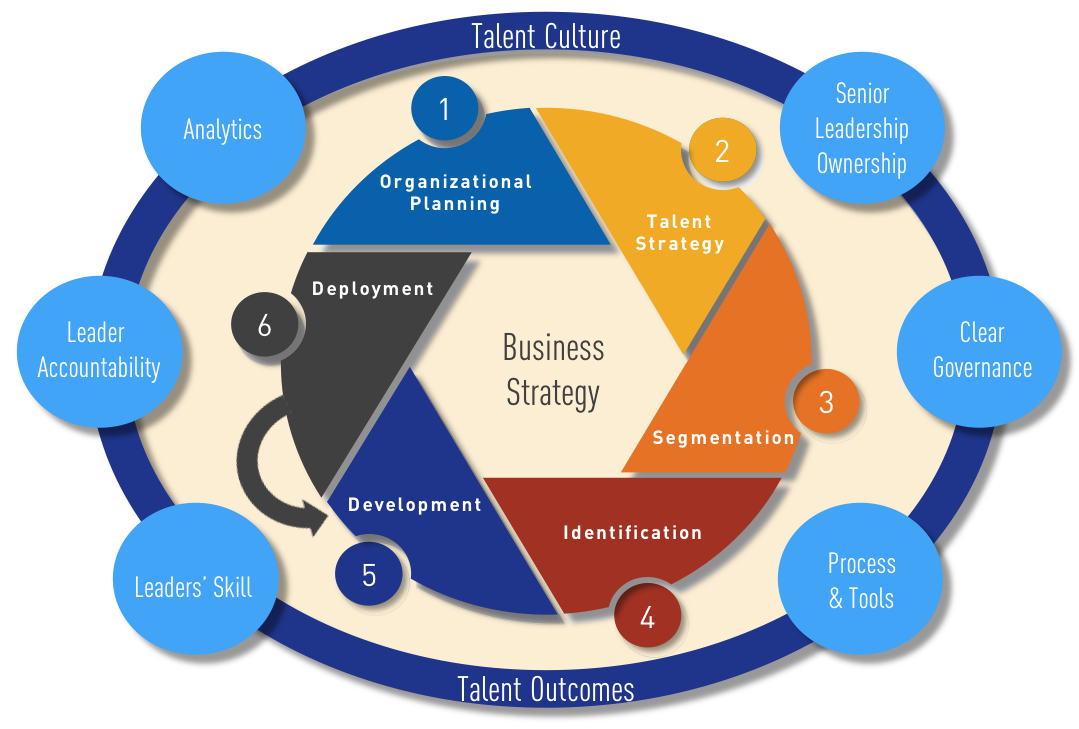The quality and leadership bench strength of companies are positively correlated to business performance. As such, there are three key differentiators for business in today’s VUCA business environment: Strategy, Leadership, and Culture. According to CEB research, a change in leadership bench strength leads to a 0.5% year-over-year change in revenue and profit. Companies with stronger bench strength have 1.9x greater revenue growth than companies with weaker bench strength and companies with stronger bench have 2.0x faster profit growth than companies with weaker bench strength.
Most mature companies have been running organizational talent reviews for years. This process is a well-oiled machine, but a question remains: are talent reviews producing Talent Outcomes? HR and business leaders voice how they struggle to fill critical roles that drive business value. Their current leadership pipeline produces few qualified leaders to meet the growing demand.
Succession management began with Boards of Directors who sought to mitigate risk at the top of the organization. It typically started with CEO succession, and while it may seem like a logical idea to cascade this approach down the organization, this notion consumes a great deal of resources without a proper return on investment. And it raises a question for most companies about how best to prepare leaders for critical roles. With a rapidly changing business environment requires a refresh of talented leaders. This only occurs when organisations create an eco-system to produce “ready now” talent. To address this challenge and provide organisations a roadmap to produce “ready now” talent, Human Edge has developed a model.
The inner circle centers on key processes. It begins with Organization Planning. Based on the latest business strategy, Organization Planning answers the question: What talent do we need to create a competitive advantage? This is the basis for Talent Strategy. With a talent strategy in place, an organization can segment their talent and identify critical roles, feeder roles and talent pools.
The next step is Talent Identification. Here, an organization determines the entry point of their talent pipeline. Most companies don’t go deep enough to identify talent, much less accelerate them to become future senior leaders. Once identified and accelerated, it usually takes 10 years to get an early talent to a senior leadership role. Without acceleration of talent, it can take 20 to 25 years to produce qualified leaders for critical roles.
Next is a focus on Development opportunities. These opportunities shape their future leaders and include mentoring and coaching programs, and equally important, on-the-job experiences. When critical roles become open, senior leaders can take bets on the leaders they have been grooming. Additionally, it’s important that organisations provide the right support. Unsupported leaders might underperform or even fail— this is known as the “hero to zero” syndrome.
Developing “ready now” leaders requires a focus on the outer circle. The outer circle builds the talent culture. It requires multiple areas of focus; one is not more than important another. When they all work together, results are produced.
Senior Leader Ownership – includes senior leaders owning, supporting, and role-modeling talent management activities. They ensure talent discussions are a part of their normal business activities and carve out time in every senior leadership meeting. Not only do senior leaders take ownership but they have joint accountabilities for talent management.
Clear Governance – is critical for the movement and deployment of talent. When governance is clear, then the decision of who will fill key roles is clear. Instead of merely filling an open role, senior leaders and HR ensure they are moving talent through a series of key roles to prepare them for future bigger roles.
Process and Tools – easy to use and technology-enabled processes and tools for leaders are critical in ensuring that the time is spent on quality discussion, not on filling in templates.
Leader Skills – as leaders give feedback, mentor, coach, and develop their direct reports, a greater likelihood that development activities will translate into capability growth.
Leader Accountability – when leaders are held accountable for talent management and are promoted and compensated for these behaviors, they dedicate the appropriate time and resources to developing talent. They become talent champions, firmly believing that human capital is critical to the organization’s success.
Analytics – when companies start connecting business and human capital data, they start to have a greater understanding of their talent risks and where there are leakages in the talent pipeline. Analytics usage can also drive senior leadership ownership and leader accountability in an organization. As predictive analytics is more widely used, it will help companies make more selected investments in talent with the greatest growth potential.
If you would like to find out the strength of your talent eco-system, request a free assessment from Human Edge by contacting at info@human-edge.com.












